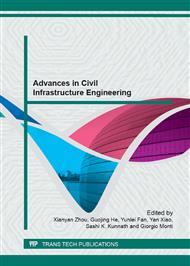p.1069
p.1073
p.1077
p.1083
p.1087
p.1092
p.1096
p.1104
p.1108
Study on the Influences of Wind Mode and Layers to Concrete Column Confined by GFRP
Abstract:
To study the mechanical property of concrete column confined by GFRP, we conducted 6 groups of specimens under axial compress. The influences of GFRP wind mode and layers were taken into account. According to the results, bearing capacity and ductility of the spiral winding specimen was improved greatly. The bearing capacity of the 6° spiral winding concrete column’s improvement is 28%, more than it of 0°. The fiber polymer’s utilization ratio can be improved greatly when column were combined with all spiral wind. Strengthen the concrete column of ±15°cross spiral winding pretend to be stronger capacity of bearing axial press than it of 6° spiral winding, but limiting strain tends to be lower. Shearing crack often happens at the 45°of the specimen, so shearing failure can be prevented effectively by GFRP (45°).Effective deformation and strength can be provided by FRP at the direction of axial and circular, and the reinforcing steel bar in concrete column can be substituted partially.
Info:
Periodical:
Pages:
1087-1091
Citation:
Online since:
January 2013
Authors:
Keywords:
Price:
Сopyright:
© 2013 Trans Tech Publications Ltd. All Rights Reserved
Share:
Citation:


